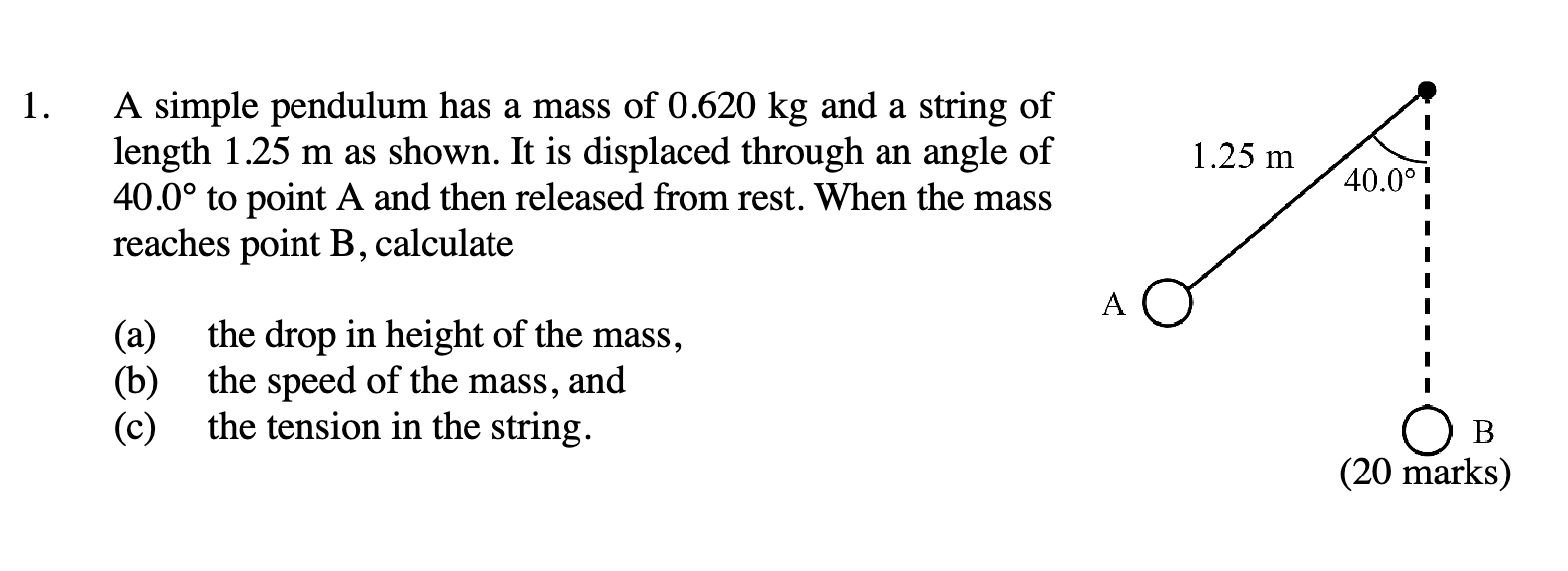A simple pendulum has a mass of 0.620 kg and a string of length 1.25 m. It is displaced through an angle of 40.0° to point A and then released from rest. When the mass reaches poin... A simple pendulum has a mass of 0.620 kg and a string of length 1.25 m. It is displaced through an angle of 40.0° to point A and then released from rest. When the mass reaches point B, calculate: (a) the drop in height of the mass, (b) the speed of the mass, and (c) the tension in the string.

Understand the Problem
The problem describes a simple pendulum system. Given the mass of the pendulum, the length of the string, and the angle of displacement, we need to calculate: (a) the vertical drop in height of the mass from point A to point B, (b) the speed of the mass at point B, and (c) the tension in the string at point B. This involves applying principles of physics related to energy conservation and circular motion.
Answer
(a) $h = 0.299 \text{ m}$ (b) $v = 2.42 \text{ m/s}$ (c) $T = 9.23 \text{ N}$
Answer for screen readers
(a) The drop in height of the mass is: $$ h = 0.299 \text{ m} $$
(b) The speed of the mass at point B is: $$ v = 2.42 \text{ m/s} $$
(c) The tension in the string at point B is: $$ T = 9.23 \text{ N} $$
Steps to Solve
- Calculate the vertical height from the pivot to point A
We use trigonometry. The vertical height from the pivot to point A is given by $l \cos(\theta)$, where $l$ is the length of the string and $\theta$ is the angle of displacement.
$$ h_A = l \cos(\theta) = 1.25 \cos(40.0^\circ) $$
- Calculate the vertical drop in height
The drop in height $h$ is the difference between the length of the string and $h_A$.
$$ h = l - h_A = l - l \cos(\theta) = l(1 - \cos(\theta)) $$ Substituting $l = 1.25 \text{ m}$ and $\theta = 40.0^\circ$: $$ h = 1.25(1 - \cos(40.0^\circ)) $$
- Calculate the speed of the mass at point B using conservation of energy
The potential energy at point A is converted into kinetic energy at point B. Therefore, $mgh = \frac{1}{2}mv^2$, where $m$ is the mass and $v$ is the speed at point B. Solving for $v$:
$$ v = \sqrt{2gh} = \sqrt{2g \cdot l(1 - \cos(\theta))} $$ Substituting $g = 9.81 \text{ m/s}^2$, $l = 1.25 \text{ m}$, and $\theta = 40.0^\circ$: $$ v = \sqrt{2 \cdot 9.81 \cdot 1.25 (1 - \cos(40.0^\circ))} $$
- Calculate the tension in the string at point B
At point B, the tension $T$ in the string must support the weight of the mass and provide the centripetal force required for circular motion.
$$ T = mg + \frac{mv^2}{l} $$ Substituting $m = 0.620 \text{ kg}$, $g = 9.81 \text{ m/s}^2$, $v$ from the previous step, and $l = 1.25 \text{ m}$: $$ T = (0.620)(9.81) + \frac{(0.620)v^2}{1.25} $$
(a) The drop in height of the mass is: $$ h = 0.299 \text{ m} $$
(b) The speed of the mass at point B is: $$ v = 2.42 \text{ m/s} $$
(c) The tension in the string at point B is: $$ T = 9.23 \text{ N} $$
More Information
The tension in the string at the bottom of the swing is greater than the weight of the mass because it also has to provide the centripetal force to keep the mass moving in a circle.
Tips
- Forgetting to convert the angle from degrees to radians when using trigonometric functions. Ensure your calculator is in the correct mode. However, in this solution, the angle is used directly in degree mode for the cosine function.
- Not recognizing that the height in the potential energy equation is the vertical drop in height, not the length of the string.
- Incorrectly applying the conservation of energy principle. Make sure to equate the initial potential energy to the final kinetic energy correctly.
- When calculating the tension, forgetting to include both the weight of the mass and the centripetal force.
AI-generated content may contain errors. Please verify critical information